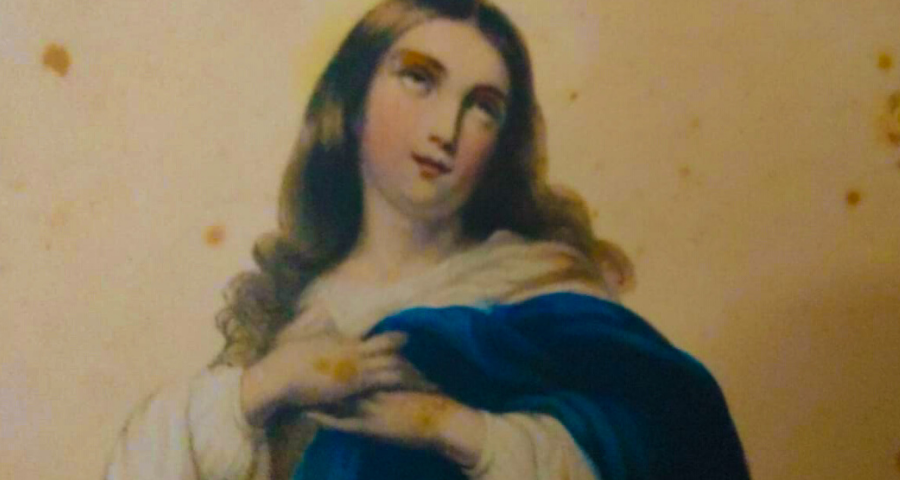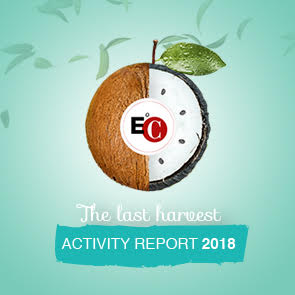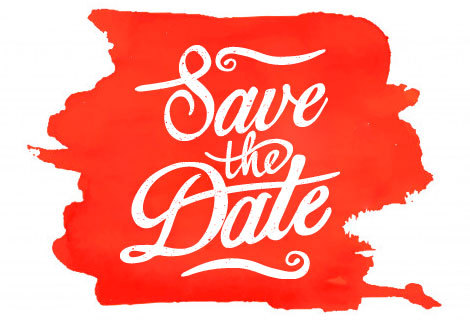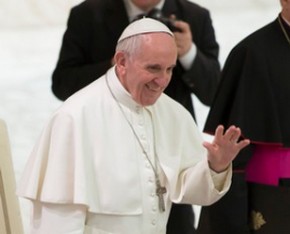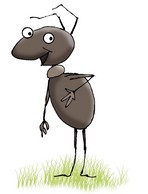Oikonomia/ 9 - Life is powerful because it is promiscuous, because it is a mix of both wheat and discord together
Avvenire 08/03/2020
"I look at the icon and say to myself: - It is Her – not a representation, but actually Her. I see the Mother of God as if I was looking through a window, the Mother of God in person, and I pray, face to face with her, not to her representation."
Pavel A. Florenskij, The royal doors: an essay on icons
Pilgrimages, relics and icons are important economic phenomena of the Middle Ages. The Protestant Reformation unwittingly favored the transition from "cult objects" to the "cult of objects" of capitalism.
Medieval pilgrimages are yet another "place" where Christianity met with the economic spirit. A very ancient phenomenon that takes up previous traditions by adding some typical elements of Christianity. Being a pilgrim was a condition that brought together all kinds of people from ecclesiastics and nobles to the poor and insolvent debtors on the run. The pilgrims' routes traced the commercial arteries of the new Europe, lined with inns and hostels around which new villages, cities and fairs were born. Walking along the Via Francigena and Via Lauretana, the pilgrim's journey joined that of the merchants: traders of both different and equal goods and products, with both similar and distant motives, a biodiversity of things and motivations that Europe contributed to generating.
Europe was born in the footwear of the countless pilgrims who walked and crossed it, dreamed and marked it for a millennium and beyond. Before the creation of the nation states, Christians met on the streets, where they listened to different languages, they practiced the old and new law of hospitality, and they learned that no man is from so far from away that he cannot be a fellow human being. That feeling that still prevails to this day of something familiar while walking from Portugal to Puglia, from Spain to Provence, is what remains of the wandering faith of our ancestors, who were European before being Italian or French. If our emigrant grandparents managed to communicate with Germans, Belgians, and Poles without knowing those languages or English, it is because they had silent but true dialogues buried in the DNA of their souls, created during centuries by the pilgrims and their nomadic faith. It took many centuries of travel, encounters, injuries and blessings to learn how to meet less than a yard away from each other, that short distance which is one of the heritages of humanity – let us not forget this in these days of necessary increased personal distance.
During the first Christian centuries, pilgrimage was an existential condition, which could last for a very long time, in some cases, even a lifetime. It was also an alternative to the monastic ascetic way of life. The pilgrim replied to the stabilitas loci of monasticism with the homo viator. Traveling became the pilgrims' labora – travel, trip and travaglio (labor) indeed all share the same root (-tr).
The medieval pilgrim is a crosser of places. Travel was not yet a way of crossing spaces back then. The journey of the pilgrim was not very different from the journey of Marco Polo, where the speed and reaching one’s destination were less important than the journey itself, as an encounter with different people and places. We are far from the rational space of modern maps, where the specific identities of places are lost in a formless model of a "homogeneous and empty" space (W. Benjamin).
From the seventh century onwards, the penitential pilgrimage, linked to sins and/or crimes, where the journey became the penance to be paid or served, began to develop. Thus, the economic-commercial dimension of the pilgrimage grew, intended as the price to pay in order to pay off a debt, a side-species to the broader kind of "tariff" penances and their highly sophisticated market. Pilgrimage became synonym with sacrifice; and as in any sacrifice, there is a price, a gift, an extinguished debt, and sometimes even a celebration, a communion involved.
Two other important medieval movements were also closely related to pilgrimages: that of relics and that of icons. A pilgrimage was in fact accomplished through the acquisition of a relic or, if too difficult or expensive, of an object, in order to be able to return home with a something, a res. The object was, as in a real contract, a necessary condition for the validity of that complex act. In fact, in the case with pilgrimages to Mecca, the Islamic ban on representing divinity lead to a complete absence of relics, icons, trade, and hence, the spirit of capitalism.
Over the centuries, the trade with relics became one of the most important commercial phenomena in Europe, initially fought by many church fathers then regulated by popes and emperors, the subject of theological disputes over their actual nature and lawfulness. The theological intrigue was not easy to unravel. The Church shared a ban on idolatry with the Hebrew Bible, that is, to worship anything other than the one and only God. Relics were by their nature exposed to the possible sin of idolatry, superstition and paganism. Moreover, these special and theologically dangerous objects were also, although with limitations and constraints, the object of trade and therefore exposed to the sin of simony.
The economic aspect is however a decisive dimension of relics. Coins transformed into relics are well known – one of Judah’s thirty coins is kept in Olivone of Blenio (in the Canton of Ticino, Switzerland), and even a sample of the land purchased with the thirty denarii was kept in in Barzanò on Lake Como until the XVII century - a sign that the sheer symbolic value exceeded the impurity of mammon. The relic acquired its value from its contact with a special body. Relics therefore had a constitutive relationship with corporeality and matter. They were an expression of the sacramental vision of reality, according to which God speaks to men also through matter and things - and we in turn talk to God through things as well: with a gift or with the work and products of our own hands. Relics and the Eucharist are very different, but both transubstantiate matter, things that while they remain what they are become something else, something invisible. The medieval man was in general much poorer than we are, but he lived in a richer world, denser with life. Things spoke more to him, and he often managed to tune into these plural voices and sometimes even managing to understand them.
Relics have something in common with the other great medieval "object", byzantine in particular: the icons. Icons are not simply sacred art. The icon is written, not painted, and has a special relationship with the face - the language of the icon is that of colors, eyes, movements of the mouth, hands and bodies. In the eyes of Orthodox theology, the author of the icon is God himself using the hand of the artist (usually a monk). The definition given by Olivier Clément is very beautiful indeed: «The icon does not belong to the magical order of possession, but to the properly Christian order of communion. It refers to the dimension of relationships, of meeting». He adds, «Looking at an icon is fasting for the eyes». It is fasting for the eyes because the icon is a spiritual exercise in using without possessing, and therefore of chastity. Looking at those beautiful eyes and faces, the most beautiful of all, for free, day by day you become a little like them. Perhaps we did not "consume" all the women and children we have looked at because all the while we carried centuries of these chaste gazes of many women and some men engraved in our souls. We learned that we were truly the "image and likeness of God" not by reading Genesis, but by looking and kissing those wonderful faces and then discovering that they resembled us. Through those "windows”, we saw paradise, and we understood that we too were a piece of heaven.
The Church fought against the cult of icons to a larger extent than that of relics. Between the VIII and IX centuries, there were iconoclastic struggles and ecumenical councils, different currents within the Church destroyed thousands of icons and erased frescoes from churches across Europe, in a quest to protect the purity of worship and combat the sin of idolatry. Partly due to other, political, reasons, not least the identity of Eastern Christianity in relation to Islam, an anti-iconic culture by definition. These champions of the purity of religion - always abundant in all ages - failed to overcome the piety of the people and their faith so different from that of theologians. One thing is certain, faith and magic, truth and deceit (false relics were abundant), religion and superstition, are all intertwined in relics and icons. They intertwine there as they intertwine in every other dimension of life, which is alive because it is promiscuous, because it is both wheat and discord, together. We have left the "enchanted world" (Charles Taylor) however. We stopped kissing icons, dreaming of saints and angels and we became depleted of present, past and future. Of course, we also dreamt of demons, but we always knew that Jesus and Mary were more beautiful and stronger, and would defeat them.
As long as relics and icons, along with cloths and spices, populated the markets, they remained plural populated with a host of different goods. Next to pepper and silk were the faces of Jesus and Mary, relics of saints and martyrs. All inhabitants of the same medieval markets.
The Protestant Reformation reacted strongly to the promiscuity of this aspect of popular faith, calling it idolatry, producing a new iconoclastic struggle, especially in Calvinist circles. As a result, there were even more statues of saints torn down, erased paintings and frescoes, fights against pilgrimages, icons and relics destroyed and even churches. Hence, in the new world now stripped of all these different goods, commodities remained the sole protagonists of the markets. The place of relics and icons was eventually taken over by commodities and their "fetishism", and that of pilgrimages by business trips and tourism with its souvenirs.
Capitalism is a cult, and no cult can exist without objects: «The starting point of culture is worship» (Pavel A. Florenskij). Christianity in the Middle Ages became culture also due to the worship of things, relics, saints, icons, and sanctuaries, while worshiping and eating a God made bread. By eliminating, any good that was not a commodity from the horizon of the modern landscape, the cult of objects was born from the cancellation of the objects of worship. With one big difference: while relics and icons could not be owned but only looked at, they could not be worshiped but only revered, goods and commodities can only be owned and adored. Another paradox and heterogenesis in terms of means to obtain an end: a Reformation born from the anti-idolatrous fight unwittingly created the conditions for capitalism, the greatest cult for adoration of objects in history. The world which they freed from (what they thought were) "idols" was not inhabited by the worship of the only God instead, but by legions of fetish-commodities. The emptiness left in people by the death of the image-presence of God within things, was instead filled with new objects, and their spirit (hau) has become that of capitalism.
Expelled from the enchanted world, we found ourselves among relics and impoverished icons. Modernity, like all revolutions, had to pay its price: the replacement of the enchantment of things with the sheer spell of commodities and goods was perhaps the highest.
Download pdf article in pdf (347 KB)

